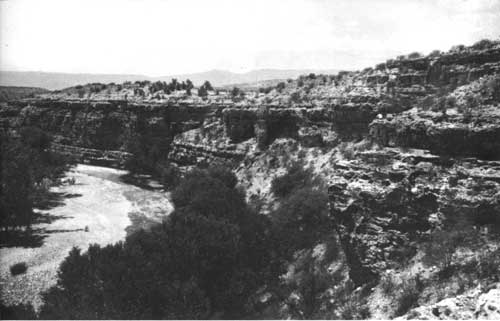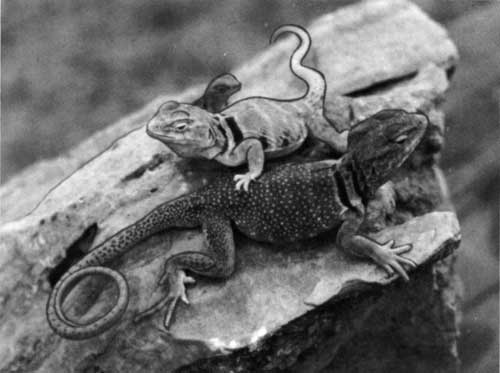|
MONTEZUMA CASTLE National Monument |
 |

Beaver Creek north of Montezuma Castle.
The Natural Scene
The landscape of the Verde Valley is wild, spectacular, and mountainous, dropping from forested mountain ranges and high mesas down to sparsely vegetated desert valleys with ribbons of dense growth bordering the valley streams. Clear desert air projects this rugged scene upon your mind with almost frightening intensity. Towering thunderheads and filmy streaks of high cirrus clouds emphasize the harshly blue skies.
Though the desert landscape looks bleak, it nourishes an astonishing variety of plant and animal life.
Typical plants of the desert flats and slopes are creosote bush, mesquite, cactus, yucca, and agave. Cottonwood, sycamore, and several species of willow flourish along streams and washes. You can see all of these plants within the monument boundaries—many of them on the nature trail below Montezuma Castle.
The monument, situated on the northern limit of the Lower Sonoran plant zone, exhibits other plants more typical of the higher region a few miles to the north where the Upper Sonoran zone begins. Some of these are hackberry, juniper, summac, and Indian paint brush.
The plant collections at Montezuma Castle include 167 species representing 49 families. The wide variety of plants within this relatively small area attracts birds and small animals in their search for food. Undoubtedly these plants were an aid in supplementing the diet of the prehistoric Indians. Many wild plants were and still are used by the Indians of the Southwest for other purposes—basketry and sandal weaving, medicines, and ceremonial uses.
In 1948 a preliminary survey was made of the plants in the Montezuma Well section 189 different plants representing 60 families were collected in that area alone. The variety of plantlife for food or other uses, in addition to the amazing water supply, made the Well a very attractive area for Indian settlement.
Many birds have been observed in the monument—149 bird species have been recorded at the Castle in 19 years of observation; and 140 species have been recorded at the Well since 1948. Many birds live in the region throughout the year, while others are seasonal visitors. Ducks and geese are plentiful in the winter, particularly at Montezuma Well, where they rest between their long flights.
The animals and reptiles of the monument are typical of this desert area. Most common are jackrabbit, cottontail rabbit, porcupine, raccoon, beaver, skunk, ground squirrel, rock squirrel, rattlesnake, bull snake, and water snake. Other forms of life which are present in the summer are lizard, black widow spider, tarantula, scorpion, centipede, and cicada (locust).

Collared lizards.
As long as you are reasonably careful about where you step and avoid putting your hands on ledges or in crevices, none of the poisonous species presents any danger.
Nature's calendar of events for this area might read as follows:
Autumn—Crisp, clear weather; time for the departure of summer birds and arrival of winter ducks; beginning of the hibernation period for snakes, lizards, and insects; termination of autumn flowers.
Winter—Usually mild with occasional snow flurries; glimpses of deer and antelope coming off the mountains into the valley; continual traffic southward of ducks and geese on migration lanes; dominance of large flocks of juncos throughout the area.
Spring— High winds and occasional rains; spring flowers coloring the slopes and mesas; influx of insects along with insect-catching birds and lizards; appearance of snakes and rodents; departure of ducks for northern breeding grounds.
Summer—Heat and occasional thunderstorms to match the drama of the survival of the fittest—insects feeding on flowers and plants; birds and lizards feeding on insects; rodents feeding on seeds and eggs; snakes feeding on rodents; hawks and owls feeding on snakes and rodents; the scavenger of the desert, the vulture, cleaning up wherever he finds his meal; and the skunk continually knocking over the garbage pail.

|

|
|
Last Modified: Mon, Jan 1 2001 10:00:00 pm PDT |


